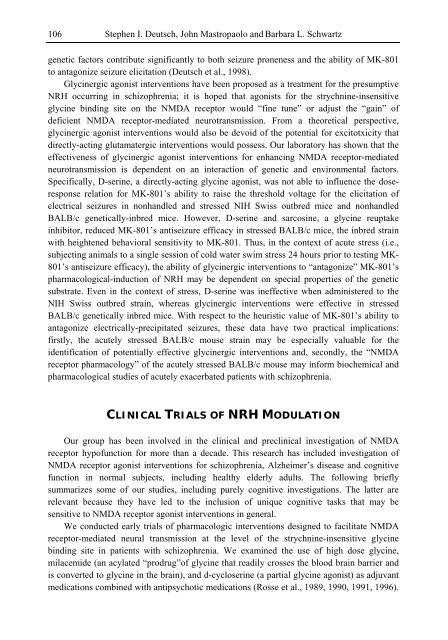Schizophrenia Research Trends
Schizophrenia Research Trends
Schizophrenia Research Trends
- No tags were found...
You also want an ePaper? Increase the reach of your titles
YUMPU automatically turns print PDFs into web optimized ePapers that Google loves.
106Stephen I. Deutsch, John Mastropaolo and Barbara L. Schwartzgenetic factors contribute significantly to both seizure proneness and the ability of MK-801to antagonize seizure elicitation (Deutsch et al., 1998).Glycinergic agonist interventions have been proposed as a treatment for the presumptiveNRH occurring in schizophrenia; it is hoped that agonists for the strychnine-insensitiveglycine binding site on the NMDA receptor would “fine tune” or adjust the “gain” ofdeficient NMDA receptor-mediated neurotransmission. From a theoretical perspective,glycinergic agonist interventions would also be devoid of the potential for excitotxicity thatdirectly-acting glutamatergic interventions would possess. Our laboratory has shown that theeffectiveness of glycinergic agonist interventions for enhancing NMDA receptor-mediatedneurotransmission is dependent on an interaction of genetic and environmental factors.Specifically, D-serine, a directly-acting glycine agonist, was not able to influence the doseresponserelation for MK-801’s ability to raise the threshold voltage for the elicitation ofelectrical seizures in nonhandled and stressed NIH Swiss outbred mice and nonhandledBALB/c genetically-inbred mice. However, D-serine and sarcosine, a glycine reuptakeinhibitor, reduced MK-801’s antiseizure efficacy in stressed BALB/c mice, the inbred strainwith heightened behavioral sensitivity to MK-801. Thus, in the context of acute stress (i.e.,subjecting animals to a single session of cold water swim stress 24 hours prior to testing MK-801’s antiseizure efficacy), the ability of glycinergic interventions to “antagonize” MK-801’spharmacological-induction of NRH may be dependent on special properties of the geneticsubstrate. Even in the context of stress, D-serine was ineffective when administered to theNIH Swiss outbred strain, whereas glycinergic interventions were effective in stressedBALB/c genetically inbred mice. With respect to the heuristic value of MK-801’s ability toantagonize electrically-precipitated seizures, these data have two practical implications:firstly, the acutely stressed BALB/c mouse strain may be especially valuable for theidentification of potentially effective glycinergic interventions and, secondly, the “NMDAreceptor pharmacology” of the acutely stressed BALB/c mouse may inform biochemical andpharmacological studies of acutely exacerbated patients with schizophrenia.CLINICAL TRIALS OF NRH MODULATIONOur group has been involved in the clinical and preclinical investigation of NMDAreceptor hypofunction for more than a decade. This research has included investigation ofNMDA receptor agonist interventions for schizophrenia, Alzheimer’s disease and cognitivefunction in normal subjects, including healthy elderly adults. The following brieflysummarizes some of our studies, including purely cognitive investigations. The latter arerelevant because they have led to the inclusion of unique cognitive tasks that may besensitive to NMDA receptor agonist interventions in general.We conducted early trials of pharmacologic interventions designed to facilitate NMDAreceptor-mediated neural transmission at the level of the strychnine-insensitive glycinebinding site in patients with schizophrenia. We examined the use of high dose glycine,milacemide (an acylated “prodrug”of glycine that readily crosses the blood brain barrier andis converted to glycine in the brain), and d-cycloserine (a partial glycine agonist) as adjuvantmedications combined with antipsychotic medications (Rosse et al., 1989, 1990, 1991, 1996).
















